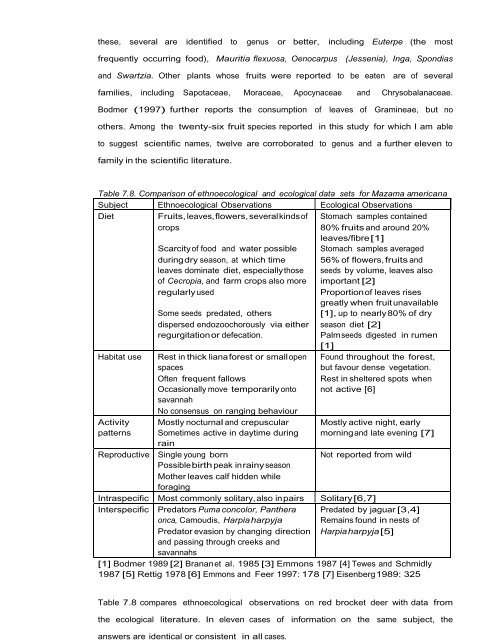Ethnoecology, Resource Use, Conservation And Development In A ...
Ethnoecology, Resource Use, Conservation And Development In A ...
Ethnoecology, Resource Use, Conservation And Development In A ...
Create successful ePaper yourself
Turn your PDF publications into a flip-book with our unique Google optimized e-Paper software.
these, several are identified to genus or better, including Euterpe (the most<br />
frequently occurring food), Mauritia flexuosa, Oenocarpus (Jessenia), <strong>In</strong>ga, Spondias<br />
and Swartzia. Other plants whose fruits were reported to be eaten are of several<br />
families, including Sapotaceae, Moraceae, Apocynaceae and Chrysobalanaceae.<br />
Bodmer (1997) further reports the consumption of leaves of Gramineae, but no<br />
others. Among the twenty-six fruit species reported in this study for which I am able<br />
to suggest scientific names, twelve are corroborated to genus and a further eleven to<br />
family in the scientific literature.<br />
Table 7.8. Comparison of ethnoecological and ecological data sets for Mazama americana<br />
Subject Ethnoecological Observations Ecological Observations<br />
Diet Fruits, leaves, flowers, several kinds of Stomach samples contained<br />
crops<br />
80% fruits and around 20%<br />
leaves/fibre [1]<br />
Scarcity of food and water possible Stomach samples averaged<br />
during dry season, at which time 56% of flowers, fruits and<br />
leaves dominate diet, especially those seeds by volume, leaves also<br />
of Cecropia, and farm crops also more important [2]<br />
regularly used<br />
Proportion of leaves rises<br />
greatly when fruit unavailable<br />
Some seeds predated, others [1], up to nearly 80% of dry<br />
dispersed endozoochorously via either season diet [2]<br />
regurgitation or defecation.<br />
Palm seeds digested in rumen<br />
[1]<br />
Habitat use Rest in thick liana forest or small open Found throughout the forest,<br />
spaces<br />
but favour dense vegetation.<br />
Often frequent fallows<br />
Rest in sheltered spots when<br />
Occasionally move temporarily onto<br />
savannah<br />
No consensus on ranging behaviour<br />
not active [6]<br />
Activity Mostly nocturnal and crepuscular Mostly active night, early<br />
patterns Sometimes active in daytime during<br />
rain<br />
morning and late evening [7]<br />
Reproductive Single young born<br />
Possible birth peak in rainy season<br />
Mother leaves calf hidden while<br />
foraging<br />
Not reported from wild<br />
<strong>In</strong>traspecific Most commonly solitary, also in pairs Solitary [6,7]<br />
<strong>In</strong>terspecific Predators Puma concolor, Panthera Predated by jaguar [3,4]<br />
onca, Camoudis, Harpia harpyja Remains found in nests of<br />
Predator evasion by changing direction<br />
and passing through creeks and<br />
savannahs<br />
Harpia harpyja [5]<br />
[1] Bodmer 1989 [2] Branan et al. 1985 [3] Emmons 1987 [4] Tewes and Schmidly<br />
1987 [5] Rettig 1978 [6] Emmons and Feer 1997: 178 [7] Eisenberg 1989: 325<br />
Table 7.8 compares ethnoecological observations on red brocket deer with data from<br />
the ecological literature. <strong>In</strong> eleven cases of information on the same subject, the<br />
answers are identical or consistent in all cases.


